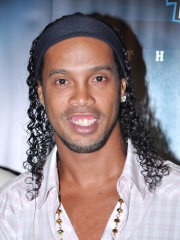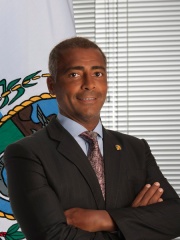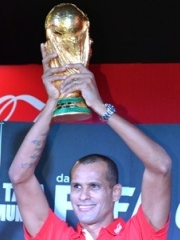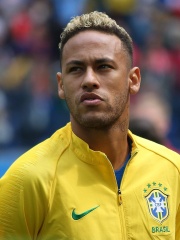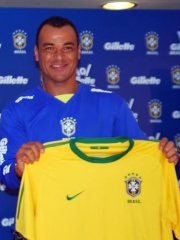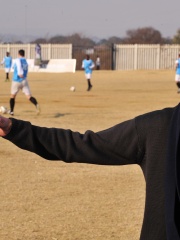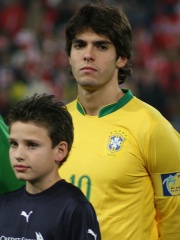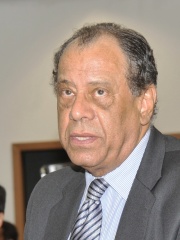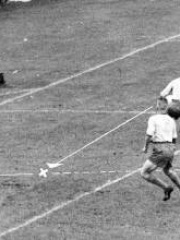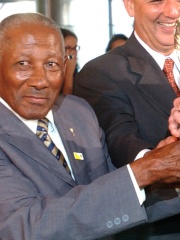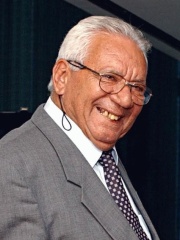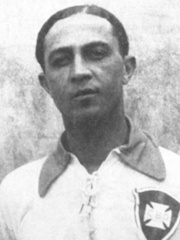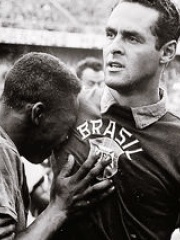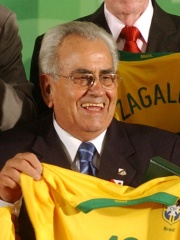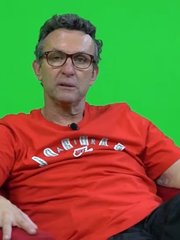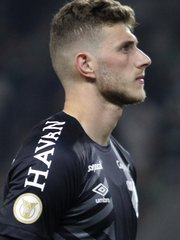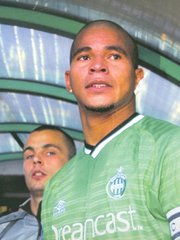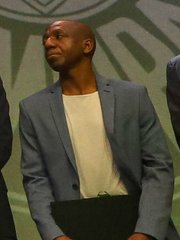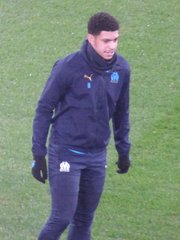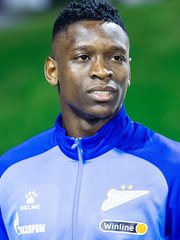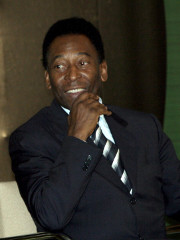
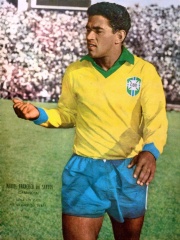
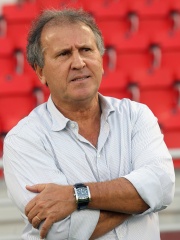
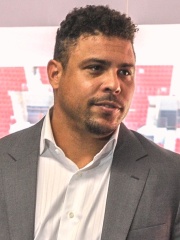
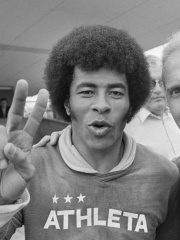
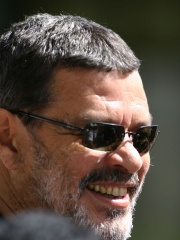
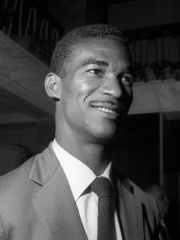
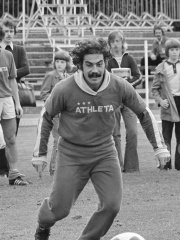
The Most Famous
SOCCER PLAYERS from Brazil
This page contains a list of the greatest Brazilian Soccer Players. The pantheon dataset contains 21,273 Soccer Players, 1,774 of which were born in Brazil. This makes Brazil the birth place of the 2nd most number of Soccer Players.
Top 10
The following people are considered by Pantheon to be the top 10 most legendary Brazilian Soccer Players of all time. This list of famous Brazilian Soccer Players is sorted by HPI (Historical Popularity Index), a metric that aggregates information on a biography's online popularity. Visit the rankings page to view the entire list of Brazilian Soccer Players.

1. Pelé (1940 - 2022)
With an HPI of 87.93, Pelé is the most famous Brazilian Soccer Player. His biography has been translated into 145 different languages on wikipedia.
Edson Arantes do Nascimento (Brazilian Portuguese: [ˈɛd(ʒi)sõ(w) aˈɾɐ̃tʃiz du nasiˈmẽtu]; 23 October 1940 – 29 December 2022), better known by his nickname Pelé (Brazilian Portuguese: [peˈlɛ]), was a Brazilian professional footballer who played as a forward. Widely regarded as one of the greatest players of all time, he was among the most successful and popular sports figures of the 20th century. His 1,279 goals in 1,363 games, which includes friendlies, is recognised as a Guinness World Record. In 1999, he was named Athlete of the Century by the International Olympic Committee and was included in the Time list of the 100 most important people of the 20th century. In 2000, Pelé was voted World Player of the Century by the International Federation of Football History & Statistics (IFFHS) and was one of the two joint winners of the FIFA Player of the Century, alongside Diego Maradona. Pelé began playing for Santos at age 15 and the Brazil national team at 16. During his international career, he won three FIFA World Cups: 1958, 1962 and 1970, the only player to do so and the youngest player to win a World Cup (17), though he only played two matches during the 1962 edition. He was nicknamed O Rei (The King) following the 1958 tournament. With 77 goals in 92 games for Brazil, Pelé held the record as the national team's top goalscorer for over fifty years. At club level, he is Santos's all-time top goalscorer with 643 goals in 659 games. In a golden era for Santos, he led the club to the 1962 and 1963 Copa Libertadores, and to the 1962 and 1963 Intercontinental Cup. Credited with connecting the phrase "The Beautiful Game" with football, Pelé's "electrifying play and penchant for spectacular goals" made him a global star, and his teams toured internationally to take full advantage of his popularity. During his playing days, Pelé was for a period the best-paid athlete in the world. After retiring in 1977, Pelé was a worldwide ambassador for football and made many acting and commercial ventures. In 2010, he was named the honorary president of the New York Cosmos. Pelé averaged almost a goal per game throughout his career and could strike the ball with either foot, as well as being able to anticipate his opponents' movements. While predominantly a striker, he could also be a playmaker, providing assists with his vision and passing ability. He would often use his dribbling skills to go past opponents. In Brazil, he was hailed as a national hero for his accomplishments in football and for his outspoken support of policies that improve the social conditions of the poor. His emergence at the 1958 World Cup, where he became a black global sporting star, was a source of inspiration. Throughout his career and in his retirement, Pelé received numerous individual and team awards for his performance on the field, his record-breaking achievements, and his legacy in the sport.

2. Garrincha (1933 - 1983)
With an HPI of 80.60, Garrincha is the 2nd most famous Brazilian Soccer Player. His biography has been translated into 72 different languages.
Manuel Francisco dos Santos (28 October 1933 – 20 January 1983), nicknamed Mané Garrincha, best known as simply Garrincha (Portuguese pronunciation: [ɡaˈʁĩʃɐ], "Southern house wren"), was a Brazilian professional footballer who played as a right winger. He is widely regarded as one of the greatest players of all time, and by many, one of the greatest dribblers ever. Garrincha played a vital role in Brazil's 1958 and 1962 World Cup victories. In 1962, when Pelé was injured, Garrincha led Brazil to a World Cup victory with a dominating performance throughout the tournament. He also became the first player to win the Golden Ball (Player of the tournament), Golden Boot (Leading Goalscorer) and the World Cup in the same tournament. He was also named in the World Cup All-Star Teams of both 1958 World Cup and 1962 World Cup. In 1994, he was named in the FIFA World Cup All-Time Team. Brazil never lost a match while fielding both Garrincha and Pelé. In 1999, he came seventh in the FIFA Player of the Century grand jury vote. He is a member of the World Team of the 20th Century, and was inducted into the Brazilian Football Hall of Fame. Due to his immense popularity in Brazil, he was also called Alegria do Povo (People's Joy) and Anjo de Pernas Tortas (Bent-Legged Angel). At club level, Garrincha played the majority of his professional career for the Brazilian team Botafogo. In the Maracanã Stadium, the home team room is known as "Garrincha". In the capital Brasília, the Estádio Nacional Mané Garrincha is named after him. He is credited for inspiring the first bullfighting chants of olé to be used at football grounds.

3. Zico (b. 1953)
With an HPI of 77.97, Zico is the 3rd most famous Brazilian Soccer Player. His biography has been translated into 71 different languages.
Arthur Antunes Coimbra (Portuguese pronunciation: [aʁˈtuʁ ɐ̃ˈtũnis koˈĩbɾɐ], born 3 March 1953), better known as Zico ([ˈziku]), is a Brazilian football coach and former player who played as an attacking midfielder. Often called the "White Pelé", he was a creative playmaker with excellent technical skills, vision and an eye for goal, he is also regarded as one of the best free kick specialists in history, able to bend the ball in all directions. By one estimate, Zico is the player that scored the most goals from direct free kicks, with 101 goals including friendlies, among which 62 verified in official games (8th of all time). In 1999, Zico came seventh in the FIFA Player of the Century grand jury vote, and in 2004 was named in the FIFA 100 list of the world's greatest living players. As stated by Pelé himself, "throughout the years, the one player that came closest to me was Zico". He was chosen as the 1981 and 1983 Player of the Year. With 48 goals in 71 official appearances for Brazil, Zico is the fifth highest goalscorer for his national team. He represented Brazil in the 1978, 1982 and 1986 World Cups. They did not win any of those tournaments, even though the 1982 squad is considered one of the greatest Brazilian national squads ever. He is widely regarded as the greatest Brazilian never to win the World Cup. Zico has coached the Japan national team, appearing in the 2006 FIFA World Cup and winning the 2004 Asian Cup, and Fenerbahçe, who were a quarter-finalist in 2007–08 in the Champions League under his command. He has also coached CSKA Moscow, Olympiacos, and the Iraq national team. He works as technical director at Kashima Antlers.

4. Ronaldo (b. 1976)
With an HPI of 77.58, Ronaldo is the 4th most famous Brazilian Soccer Player. His biography has been translated into 106 different languages.
Ronaldo Luís Nazário de Lima (Brazilian Portuguese: [ʁoˈnawdu luˈiz naˈzaɾju dʒi ˈlimɐ]; born 18 September 1976), mononymously known as Ronaldo, is a Brazilian former professional footballer who played as a striker. He is the owner and president of La Liga 2 club Real Valladolid. Nicknamed "o fenômeno (The Phenomenon)" and R9, he is widely regarded as one of the greatest players of all time. As a multi-functional striker who brought a new dimension to the position, Ronaldo has been an influence for a generation of strikers that have followed. His individual accolades include being named FIFA World Player of the Year three times and winning two Ballon d'Or awards. Ronaldo started his career at Cruzeiro and moved to PSV in 1994. He joined Barcelona in 1996 for a then world record transfer fee and at 20 years old, he was named the 1996 FIFA World Player of the Year, making him the youngest recipient of the award. In 1997, Inter Milan broke the world record fee to sign Ronaldo, making him the first player since Diego Maradona to break the world transfer record twice. At 21, he received the 1997 Ballon d'Or and remains the youngest recipient of the award. By the age of 23, Ronaldo had scored over 200 goals for club and country. However, after a series of knee injuries and recuperation, he was inactive for almost three years. Ronaldo joined Real Madrid in 2002 and won the 2002–03 La Liga title. He had spells at AC Milan and Corinthians before retiring in 2011, having suffered further injuries. Ronaldo played for Brazil in 98 matches, scoring 62 goals and is the third-highest goalscorer for his national team. At age 17, he was the youngest member of the Brazilian squad that won the 1994 FIFA World Cup. At the 1998 FIFA World Cup, Ronaldo received the Golden Ball as the player of the tournament after he helped Brazil reach the final, where he suffered a convulsive fit hours before kick-off. He won the 2002 FIFA World Cup, starring in a front three with Ronaldinho and Rivaldo. Ronaldo scored twice in the final and received the Golden Boot as the tournament's top goalscorer. This achievement, viewed as "redemption" for what occurred at the previous World Cup, saw Ronaldo named the 2002 FIFA World Player of the Year, receive the 2002 Ballon d'Or, and for his return from injury, won the Laureus World Sports Award for Comeback of the Year. At the 2006 FIFA World Cup, Ronaldo scored his 15th World Cup goal, a tournament record at the time. He also won the 1997 Copa América, where he became the player of the tournament and the 1999 Copa América, where he was the top goalscorer. Ronaldo was one of the most marketable sportsmen in the world during his playing career. He was named in the FIFA 100 list of the greatest living players compiled in 2004 by Pelé and was inducted into the Brazilian Football Museum Hall of Fame, Italian Football Hall of Fame, Inter Milan Hall of Fame and Real Madrid Hall of Fame. In 2020, Ronaldo was named in the Ballon d'Or Dream Team, a greatest all-time XI published by France Football magazine. Ronaldo has continued his work as a United Nations Development Programme Goodwill Ambassador, a position to which he was appointed in 2000. Ronaldo became the majority owner of Real Valladolid in September 2018, after buying 51% of the club's shares. In December 2021, he bought a controlling stake in his boyhood club Cruzeiro, investing $70 million in the club. He sold his stake in Cruzeiro in April 2024.
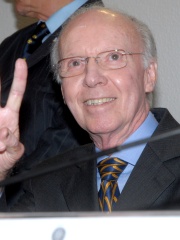
5. Mário Zagallo (1931 - 2024)
With an HPI of 75.76, Mário Zagallo is the 5th most famous Brazilian Soccer Player. His biography has been translated into 58 different languages.
Mário Jorge Lobo Zagallo (Portuguese pronunciation: [ˈmaɾju zaˈɡalu]; 9 August 1931 – 5 January 2024) was a Brazilian professional football player, coordinator and manager, who played as a forward. Zagallo holds the record for FIFA World Cup titles in general with four titles in total. He also holds the record for World Cup finals with five participations. He was the first person to win the World Cup as both a manager and as a player, winning the competition in 1958 and 1962 as a player and in 1970 as manager. In addition, he won the 1994 FIFA World Cup as assistant manager. Zagallo also coached Brazil in 1974 (finishing fourth) and in 1998 (finishing as runners-up) and was a technical assistant in 2006. He was the first of three men, along with Germany's Franz Beckenbauer (who coincidentally died two days after Zagallo) and France's Didier Deschamps to have won the World Cup as a player and as a manager, and the only one who had done each more than once. In 1992, Zagallo received the FIFA Order of Merit, the highest honour awarded by FIFA, for his contributions to football. He was named the ninth greatest manager of all time by World Soccer Magazine in 2013. On 5 January 2024, Zagallo died at the age of 92. He was the last surviving Brazilian player who participated in the 1958 World Cup final, and his death left Amarildo as the last surviving Brazilian player of the 1962 final.

6. Jairzinho (b. 1944)
With an HPI of 75.49, Jairzinho is the 6th most famous Brazilian Soccer Player. His biography has been translated into 47 different languages.
Jair Ventura Filho (born 25 December 1944), better known as Jairzinho (Portuguese pronunciation: [ʒaˌiʁˈzĩɲu]), is a Brazilian former professional footballer. A quick, skillful, and powerful right winger known for his finishing ability and eye for goal, he was a key member and leading scorer of the Brazil national team that won the 1970 FIFA World Cup. Jairzinho was nicknamed "the Hurricane" (Portuguese: o Furacão) in reference to the way his jersey would shake as he ran down the wing during his playing days. A versatile forward, he was also capable of playing in a variety of other attacking positions, as a main striker, second striker, or even as an attacking midfielder. He was known for his large afro towards the later stages of his career, as well as his burst of pace, dribbling, ball skills, finishing ability, shot power and physical strength due to his large muscular build. He is widely considered one of the greatest Brazilian players of all time. Due to the economic and political situation of the time, as well as the Sport Legislation, Jairzinho played most of his club football in South America where he spent eleven years at Rio de Janeiro club Botafogo. He went on to play in Europe for Olympique de Marseille during the final years of his career, a common pattern for South American players until the 1980s, when the economic and political situation changed. Jairzinho replaced his footballing idol Garrincha in both the Botafogo and Brazil teams, and played in three consecutive World Cups: 1966, 1970 and 1974.

7. Sócrates (1954 - 2011)
With an HPI of 75.47, Sócrates is the 7th most famous Brazilian Soccer Player. His biography has been translated into 60 different languages.
Sócrates Brasileiro Sampaio de Souza Vieira de Oliveira (19 February 1954 – 4 December 2011), simply known as Sócrates [ˈsɔkɾat͡ʃis], was a Brazilian footballer who played as a midfielder. His medical degree and his political awareness, combined with style and quality of his play, earned him the nickname "Doctor Socrates". Easily recognizable for his beard and headband, Sócrates became the "symbol of cool for a whole generation of football supporters". In 1983, he was named South American Footballer of the Year. In 2004, he was named by Pelé in the FIFA 100 list of the world's greatest living players. He is widely regarded as one of the greatest midfielders of all time. Sócrates played for Brazil for seven years, scoring 22 goals and representing the nation in two World Cups. He captained the team in the 1982 FIFA World Cup; playing in midfield alongside Zico, Falcão, Toninho Cerezo and Éder, considered one of the greatest Brazil national teams ever. He also appeared in the 1979 and 1983 Copa América. At club level, Sócrates played for Botafogo-SP before joining Corinthians in 1978. Representing Botafogo, Sócrates was the highest goalscorer in the 1976 Campeonato Paulista da Divisão Especial de Futebol Profissional. He moved to Italy to play for Fiorentina, returning to Brazil in 1985 to end his career. His younger brother Raí played in the same position as him and was a member of the Brazilian team that won the World Cup in 1994. Raí is best known for his tenures at São Paulo and Paris Saint-Germain.

8. Didi (1928 - 2001)
With an HPI of 75.31, Didi is the 8th most famous Brazilian Soccer Player. His biography has been translated into 49 different languages.
Waldyr Pereira (8 October 1928 – 12 May 2001), also known as Didi (Brazilian Portuguese: [dʒiˈdʒi]), was a Brazilian footballer who played as a midfielder or as a forward. He played in three FIFA World Cups (1954, 1958, and 1962), winning the latter two. An elegant and technical player, Didi was renowned for his range of passing, stamina and technique. He also was a free-kick specialist, being famous for inventing the folha seca (dry leaf) dead ball free kicks, notably used by modern-day players such as Juninho and Cristiano Ronaldo, where the ball would swerve downward unexpectedly at a point resulting in a goal. During his career, he was part of Fluminense between the end of the 1940s to the mid-1950s and one of the main players of the iconic squad of Botafogo in the early 1960s with other world champions such as Garrincha, Nilton Santos, Zagallo and Amarildo.

9. Rivellino (b. 1946)
With an HPI of 75.24, Rivellino is the 9th most famous Brazilian Soccer Player. His biography has been translated into 61 different languages.
Roberto Rivellino (Brazilian Portuguese: [ʁoˈbɛʁtu ʁiveˈlĩnu]; born 1 January 1946), known as just Rivellino, is a Brazilian football pundit and former player who was one of the key members of Brazil's 1970 FIFA World Cup-winning team. The son of Italian immigrants from Macchiagodena, Isernia, he played as an attacking midfielder and was famous for his iconic moustache, bending free kicks, long range shooting, accurate long passing, vision, close ball control and dribbling skills. He also perfected a football move called the "flip flap", famously copied by Romário, Mágico González, Ronaldo, Ronaldinho and Cristiano Ronaldo in later years. A former attacking midfielder, he is widely regarded as one of the most graceful football players ever, and one of the greatest players of all time. With the close control, feints and ability with his left foot, Diego Maradona named Rivellino among his greatest inspirations growing up. In 2004, he was named by Pelé in the FIFA 100 list of the world's greatest living players. Rivellino currently works as a pundit for TV Cultura.
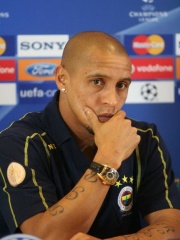
10. Roberto Carlos (b. 1973)
With an HPI of 74.66, Roberto Carlos is the 10th most famous Brazilian Soccer Player. His biography has been translated into 79 different languages.
Roberto Carlos da Silva Rocha (born 10 April 1973), often recognized as Roberto Carlos and sometimes RC3, is a Brazilian former professional footballer. He has been described as the "most offensive-minded left-back in the history of the game", and one of the greatest full-backs in history. In 1997, he was runner-up in the FIFA World Player of the Year and in 2002, was runner-up for the Ballon d'Or. He is primarily known for his long career at Real Madrid and constant presence on the Brazilian national team. He started his career in Brazil as a forward but spent most of his career as a left-back. At club level, Roberto Carlos joined Real Madrid from Inter Milan in 1996 to spend 11 highly successful seasons, playing 584 matches in all competitions and scoring 71 goals. At Real, he won four La Liga titles and the UEFA Champions League three times. In April 2013, Marca named him in their "Best Foreign Eleven in Real Madrid's History". He is one of the few players to have made over 1,100 professional career appearances at clubs and international levels. Roberto Carlos made his debut for the Brazil national team in 1992. He played in three World Cups, helping the team reach the final in 1998 in France, and win the 2002 tournament in South Korea and Japan. He was named in the FIFA World Cup All-Star Team in 1998 and 2002. With Brazil, he is especially known for a bending 40-yard free kick against France in the inaugural match of Tournoi de France 1997. With 125 caps, he has made the fourth-most appearances for his national team. He was chosen for the FIFA World Cup Dream Team in a 2002 FIFA poll. He took up management and was named as the manager of Sivasspor in the Turkish Süper Lig in June 2013. He resigned as head coach in December 2014. From January to June 2015, he was manager of Akhisarspor. Although he announced his retirement from playing at the age of 39 in 2012, he briefly came out of retirement in 2015 when he was appointed player/manager of Indian Super League club Delhi Dynamos.
People
Pantheon has 1,774 people classified as Brazilian soccer players born between 1874 and 2007. Of these 1,774, 1,585 (89.35%) of them are still alive today. The most famous living Brazilian soccer players include Zico, Ronaldo, and Jairzinho. The most famous deceased Brazilian soccer players include Pelé, Garrincha, and Mário Zagallo. As of April 2024, 169 new Brazilian soccer players have been added to Pantheon including Dorival Júnior, Edinho, and Fernando Diniz.
Living Brazilian Soccer Players
Go to all RankingsZico
1953 - Present
HPI: 77.97
Ronaldo
1976 - Present
HPI: 77.58
Jairzinho
1944 - Present
HPI: 75.49
Rivellino
1946 - Present
HPI: 75.24
Roberto Carlos
1973 - Present
HPI: 74.66
Ronaldinho
1980 - Present
HPI: 73.81
Romário
1966 - Present
HPI: 73.43
Rivaldo
1972 - Present
HPI: 71.53
Neymar
1992 - Present
HPI: 70.63
Cafu
1970 - Present
HPI: 70.48
Bebeto
1964 - Present
HPI: 70.37
Kaká
1982 - Present
HPI: 70.34
Deceased Brazilian Soccer Players
Go to all RankingsPelé
1940 - 2022
HPI: 87.93
Garrincha
1933 - 1983
HPI: 80.60
Mário Zagallo
1931 - 2024
HPI: 75.76
Sócrates
1954 - 2011
HPI: 75.47
Didi
1928 - 2001
HPI: 75.31
Carlos Alberto Torres
1944 - 2016
HPI: 73.89
Vavá
1934 - 2002
HPI: 72.60
Djalma Santos
1929 - 2013
HPI: 72.48
Nílton Santos
1925 - 2013
HPI: 71.84
Arthur Friedenreich
1892 - 1969
HPI: 71.77
Gylmar dos Santos Neves
1930 - 2013
HPI: 70.87
Zito
1932 - 2015
HPI: 70.31
Newly Added Brazilian Soccer Players (2025)
Go to all RankingsDorival Júnior
1962 - Present
HPI: 56.93
Edinho
1970 - Present
HPI: 48.99
Fernando Diniz
1974 - Present
HPI: 48.70
Neto
1966 - Present
HPI: 47.55
Bento
1999 - Present
HPI: 46.46
Lucas Beraldo
2003 - Present
HPI: 46.28
Aloísio Chulapa
1975 - Present
HPI: 45.59
Amaral
1973 - Present
HPI: 45.56
Luis Henrique
2001 - Present
HPI: 45.00
Luiz Henrique
2001 - Present
HPI: 44.54
Éderson
1999 - Present
HPI: 44.37
Adriano Gabiru
1977 - Present
HPI: 44.26
Overlapping Lives
Which Soccer Players were alive at the same time? This visualization shows the lifespans of the 25 most globally memorable Soccer Players since 1700.

